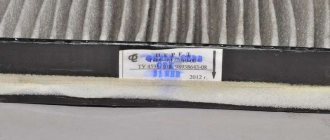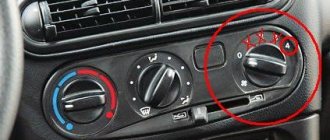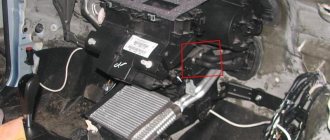Heater VAZ 2121, 21213, 21214, 2131 modernized, in collection. with body
The heater is designed for installation on VAZ 2121, 21213, 21214, 2131, Lada 4×4 cars.
The heater is a plastic housing with a built-in electric motor and air blower.
It has a number of advantages over a standard heater:
- The motor is easy to install. Practical silent operation.
- Three-position switch.
- Increased heating speed and air flow into the cabin.
The serial motor with a fan in the cabin can be removed (removal/installation steps are carried out in accordance with routine maintenance), but if you want to have a spare option, you can leave it. In this case, the old motor with an impeller will provide some resistance to air movement
Heater assembly Airflow mode switch Wiring harness Fasteners Air flow distributor
1. The serial motor with a fan in the cabin can be removed (removal/installation steps are carried out in accordance with routine maintenance), but if you want to have a spare option, you can leave it. In this case, the old motor with the impeller will provide some resistance to air movement. 2. If desired, the standard heater can be kept in working order as a backup. In this case, it will be necessary to connect an additional positive wire to the new heater and take into account that the simultaneous operation of both heaters will create an increased load on the vehicle’s on-board electrical network, which is extremely undesirable.
By clicking on the button you will receive all the information on delivery and payment of the method convenient for you to receive the goods. Our employees will calculate for you the most profitable method of delivering the goods you have chosen.
Pickup for everyone who is convenient in Moscow to independently pick up and pay for the goods you have chosen.
Delivery by mail or EMS Post. It is preferable for buyers who live in areas where there are no branches of transport companies nearby. Some goods can be sent by mail (restrictions on weight and dimensions). We will advise you on a more convenient delivery method.
We deliver by courier only in Moscow and the Moscow region. The buyer provides the address and telephone number of the place of delivery of the goods, full name. person responsible for receiving the goods, his phone number. When transferring the goods to the Buyer (Representative), the quality, quantity, and completeness of the transferred goods are checked.
Delivery by transport companies is the most convenient and profitable and often the only way to receive the spare parts you ordered. We work with any Transport companies convenient for you. Which are located in Moscow.
Excerpt from the Warranty Conditions for Auto Parts"
1.1. The warranty period (except for electrical parts) for original spare parts is 6 (six) months or 30 (thirty) thousand km. mileage, and 3 (three) months or 5 (five) thousand km. mileage if the purchased Product belongs to the “non-original” category (whichever occurs earlier), unless otherwise determined by the Manufacturer or Seller of this spare part. You can familiarize yourself with the full terms of the warranty by following the link: Warranty terms for Auto Parts
Fault Diagnosis
The stove supplied as standard will need to be modified for preventive purposes. The procedure will not take much time, but it will prevent many problems in the future. Driving experience suggests that the first severe frosts will undermine the “health” of the device. The list of main weaknesses is as follows:
- the optimal operating temperature range for model 2121 is from -5 to +10°C;
- inability to warm up the air in the cabin if outside is -8°C or lower;
- when the blowing power increases, the temperature does not increase;
- When driving in 2nd gear, the noise from the Niva's stove becomes significant.
That is why it is better to take the necessary measures in advance. The driver has few alternatives. On the one hand, everything remains in its place. The heating device is used at minimum power. During mild winters this is still tolerable, but with the onset of real cold weather the conditions will become unbearable. On the other hand, it's easy to spend a few hours rectifying the situation.
The presence of an unpleasant sound indicates the need to replace the device. A specialized retail network offers ready-made options for heating mechanisms for Niva. If desired, it can be assembled independently.
The second option is considered more preferable. When you assemble it yourself, you have the opportunity to literally personalize the stove. To do the work yourself, you will need to visit a specialized store or market to buy spare parts.
When purchasing, original parts or analogues are selected. The main thing is that they have a quality certificate. Otherwise, they cannot be installed. It would be useful to rewrite the technical data of the vehicle so as not to exceed the parameters recommended by the manufacturer.
Lada 4×4 3D Niva 96 › Logbook › Hot stove in Niva. Part 2.
In preparation for the “white flies” season, I installed a modified stove, and its modification consisted of the following: 1) a significant reduction in noise; 2) increase in fan performance; 3) increased heat transfer from the radiator.
And now first things first. Reducing noise and increasing fan performance is achieved by installing a heater fan from a VAZ2108 in the boot. An increase in heat transfer is achieved by installing a heater radiator from Shniva (it has a larger number of fins because it is designed for a much larger interior volume) and it is free of blunt flange connections and a heater valve from a VAZ 2108 (its flow area is much larger than that of a classic one). For one thing, I decided to install a thermostat from Shniva in order to get rid of the tube that I don’t like that goes from the stove along the block, but this is not all the charms of the Shniva-thermostat, its highlight is that the stove with it heats much better due to the fact that the cooled return The stove entering the thermostat cools its thermoelement, thereby closing it and hotter coolant flows into the stove.
Thanks to this, we get rid of the steeply curved hose to the stove, which is so inconvenient to change.
Now about the nuances of the installation process.
The beginning is usual: the protection is removed, the coolant is drained, the main thing is to take care of the generator and cover it with a plastic bag, and it is convenient to drain it by disconnecting the intake manifold heating hose.
While the liquid is draining, you can begin dismantling the heater housing
and heater air intake (“boot”)
Having removed the heater core I saw a wild gasket
Find 8 differences from the new gasket :) in particular, and because of this, I decided to switch to the Shniv radiator, the hoses are not connected to it through flanges, but are put on the pipes coming from the radiator. The radiator was a copper three-row one, made by Sovdepov
The radiator seemed fine, but it was clogged with wheat, bumblebees and other offal.
After draining the coolant, the supply pipe is disconnected from the pump, the one that goes from the stove behind the starter and a plug is put in its place,
in my case, it was a sawn-off flange from a removed pipe, under which I placed a piece of tin and coated it with sealant. While the plug with sealant was growing into place, I began to do the most important thing - adjusting the parts with a grinder and a file. First of all, I tried on a “boot” with a snail for the place of their further registration. In general, I saw what I expected - the hood lock does not allow them to be placed there. Problem? No! I called the Bulgarian’s evil wife from the shelf and, after making sure that there was no snail impeller in the affected area, I removed everything unnecessary.
What to do with a hole, oh with a hole? Tape it up. From the shelf I took out a sheet of vibroplast with foil. In my opinion, the best thing is to stick it in two layers and roll it thoroughly. The result is the following:
Now the boot fits into place without problems and the hood lock does not interfere with it and it does not interfere with the lock. Well, little by little we sorted out the boot, now it’s up to the shniva-radiator.
As it is, of course it won’t fit, you need to remove the excess and then the radiator fits in as if it were original, only a little diagonally, the part that with the pipes will stick out a little, this is normal. Next, you need to plug the cutouts for the pipes of the old radiator, and again the vibroplast from the shelf came to the rescue :) glued it on both sides.
From the bottom box I removed everything that interfered with the installation of the pipes, connected all this equipment and sealed all unnecessary holes with vibroplast, and filled the gaps between the radiator and the body with foam rubber.
Then, while everything was on the table, I began to try on the hoses of the VAZ-2108 heater that I had in stock
Lubricate the pipes with grease
(this is important so that later, when tightening the clamps, the hose can freely fit around the pipe) and mount the hoses (it is also necessary to put lubricant under the clamps because the coefficient of adhesion between metal and rubber is quite high and when the clamp is further tightened, it can make a fold on the hose, and tightening the clamp will be much easier ).
During work, I tested two brands of clamps; initially I wanted to install NORMA clamps in a circle, but it so happened that the store did not have the required Norma diameter and I bought “Mayak” clamps. They look the same as the norm, but when tightened, the Mayak clamps come off with much less force than the Norma clamps, so this is KETAI crap in the firebox, only Norma clamps will be used from now on.
All the parts have been adjusted, now the most interesting SECAS is the installation of the lower box assembled with the radiator; for this, the lining of the floor tunnel was removed. With the help of some mother, it all somehow fit into place, but now we have to somehow manage to screw it all together without outside help. A little ingenuity and things got better. Using improvised means, I supported the bolts from the top
Four bolts and the “Boot” and the stove body are out of place
Source
Technical details of the procedure
The efficiency of the new heating system on Niva will be determined not by the cost of the purchased parts, but by their quality. To operate, you will need the following elements: a car resistor, a figure-eight heater and a “snail”. It is a mistake to believe that only “original” spare parts are suitable for repairing a heating device. The main requirement is technical compatibility.
If in doubt, a drawing of the heating system will provide clarity. The further procedure is as follows:
- Cut a new mounting hole. This is done carefully, because the reliability of the heating system’s operation depends on the quality of the preparatory process. It is recommended to place the engine as low as possible in the air duct, otherwise the device will rest against the hood. This should not be allowed to happen, otherwise the stove fan will not last long.
The heating system of a new model is checked by test switching on. It is recommended to switch modes smoothly. The device must remain on each of them for at least 5-7 minutes. The driver’s task is to make sure that the operation of the system is not accompanied by extraneous noise and vibration.
Self-installation of a new stove
Despite the fact that the figure-eight heater fits the Niva, you still have to work a little to install it - the products of the domestic auto industry do not imply that some part is simply replaced without effort. It will definitely be necessary to sharpen, drill, remake, and so on, so that all the parts become normal.
For the stove from the VAZ-2108, you should immediately purchase a new resistor, switch and “snail”. The procedure is as follows:
- Try the engine from the new stove to the air duct and cut a new mounting hole. The engine should be installed so that it does not rest against the hood, so try to place it deeper into the air duct;
- Remove the wire from the box, carefully secure and seal the engine itself;
- Cut out a plate from stainless steel that needs to be installed under the nozzle;
- The top opening also needs to be closed;
- Remove the standard valve, as it will not be needed in the new stove;
- Reinstall the air duct.
If you don’t want to do construction, you can purchase a ready-made kit assembled. It includes a volute, a housing with a pre-prepared seat for the engine, a rheostat, a speed switch, a set of wires, as well as fasteners and sealing connections.
- this is a headache for any “nivovod”. What principles guided the designers when developing it, but it can’t be called anything other than quiet horror.
This is not to say that she has many shortcomings. There are only two of them - but this is more than enough to think about replacing or remodeling it.
Firstly, it completely fails to cope with its functions. At temperatures in the range of +10...-5 degrees, the cabin is even more or less warm. But as soon as the temperature drops below -5..-10 degrees, the cold is felt even at maximum blowing power, not to mention the lower temperatures that are quite common in our winter - in this case the windows simply freeze and you have to clean the “portholes” "
Secondly, when operating at maximum (second) speed, the fan makes such noise and squealing that it even blocks the operation of the motor. Not everyone can withstand this cacophony, so drivers reduce the airflow to first speed. As a result, the car does not warm up enough and the windows begin to freeze.
Original parts vs analogues: practical advice
As mentioned earlier, such a choice does not affect the quality of the heating system. At the same time, car mechanics make several reservations. For those who plan to use VAZ stoves, it would be useful to check the power system. It is different for some modifications. That is why all actions are consistent with the drawings.
It is permissible to use the VAZ 2108 heater, provided that two recommendations are followed. Firstly, the mounting socket is 1-2 cm larger than the size of the device. The additional area will reduce the vibration impact. Secondly, the switch is installed taking into account the specifics of the VAZ heating system. You will have to tinker less when minor modifications to the system are needed.
The ventilation system is updated in 1-2 hours, depending on the degree of wear of the engine.
If the factory-installed “snail” has no signs of physical wear, you only need to replace the heater “engine” itself.
It’s worse if the factory equipment of a Chevrolet model has manufacturing defects. A complete replacement of the device is recommended. This will save time.
The operation of the heating system determines the comfort and safety of driving. The driver constantly monitors the system's performance. If extraneous noise appears, it is necessary to urgently carry out a technical inspection.
Lada 4×4 3D I want a diesel › Logbook › Additional heater for the Niva’s interior
Good afternoon! So I decided to update my board magazine. Almost two years ago, an additional heater was installed in the car interior under the passenger seat. I ordered the stove on the Niva tuning website 24/7. This product is manufactured from serial spare parts. Heater radiator from VAZ 2108, fan motor from VAZ 2101-07. Only the stove body is original. I started the installation by removing the passenger seat and the main heater radiator. Next I cut off the radiator outlet pipe. as shown in the picture.
. The stove comes with hoses, pipes and metal tubes.
One of the pipes needs to be trimmed (photo below)
And using this pipe we connect one of the tubes to the radiator
We attach the second similar tube to the pipe that goes from the radiator to the thermostat
. Next, I try on the new stove in place and secure it with an elastic cord. Settle into place like a native. The seat on top fits very well, although the seat locking lever needs to be modified.
We install the main heating radiator in place and begin laying hoses to the additional stove.
We lay the hoses, connect them to the radiators and secure them with brackets for fastening the metal corrugation.
Next, I assembled the torpedo, installed the “beard” and the storage shelf.
In order to install the seat, you need to bend the lever that secures the seat.
And install the seat.
Next, I filled in antifreeze and bled the system. The car became noticeably warmer, but not enough. In addition to everything else, it was decided to install an electric pump.
Antifreeze circulation passes first through the main radiator, and then into the additional stove. At the moment I am happy with the stove. True, I had to replace the fan motor, because... From the first moment it made a noise like a vacuum cleaner. With the pump installed at minus 37 in the rear seats, passengers felt quite comfortable, and sometimes even asked to turn off the heater. And in general it became much warmer in the car. I'm happy with the heater, although I rarely use it (winters have become milder). But of course I would like the stove to be collapsible. Because when replacing the fan, I had to drill out the rivets and then put everything on double-sided tape.
Comprehensive modification of the stove/heater of Niva 4x4 (VAZ 2121, 2131)
Having set out to increase the efficiency of my car's heater, I re-read the available methods on the forums, and realized that these methods have some drawbacks that did not suit me. For example, installing a fan from a VAZ 2108 allows you to increase the air flow through the heater and blower nozzles, but this air is taken from the street, it is icy, and therefore the interior begins to warm up only after the engine has completely warmed up. In addition, this method requires significant modifications to the design of the heater, as well as the cost of purchasing a fan. Next, I’ll tell you how to modify the stove on the Niva with your own hands without investment and in a short time.
The Niva Pechka website has received an updated design and is available on mobile devices.
We have launched an updated version of the Niva-pechka website. Now it is convenient to use the Niva-Pechka website on mobile devices. As before, no outside advertising. Only useful information regarding ventilation and heating of the Niva LADA 4×4 URBAN car. How to make Niva more comfortable and easier to use. How to independently install a Niva stove with a cabin filter in your home garage. And other questions on how to make Niva better. We hope you will find it convenient to use our website nivapechka.com
15.03.2015
Improvement No. 1. We take air from the cabin
The main disadvantage of the Niva heater is that all the air into the heater radiator comes from the street, and when the air intake flap is closed, air circulation and heating stop completely. To eliminate this drawback, I disassembled the heater (I had to drain some of the antifreeze and disconnect the heater radiator pipes), and in the side wall of the heater housing, opposite the wall where the radiator tubes exit, I made a hole in the shape of a rectangular trapezoid. I did it in such a way that there was 1.5-2 mm of the body wall left to the boundaries of the plane in which I made the hole, and 6-8 mm from the side of the stiffener for attaching the petal valve. I made the hole using a drill, marked it, drilled along the contour of the small diameter holes, then connected the holes using a knife, then filed the edges of the resulting hole, giving it its final shape. The area of the resulting hole was approximately 25 square centimeters. It is through this hole, when the heater air intake flap is closed, that air is drawn from the passenger compartment.
Since the salon is a closed space, air circulation occurs in a closed circle, and the warming up air of the salon, passing through the heater radiator, becomes increasingly hotter at the exit. Despite the small size of the hole, due to the absence of a supply of icy air from the street, the time for warming up the interior to a comfortable temperature and melting icy glass is reduced by 4-5 times, and it is possible to achieve a comfortable temperature even in severe frost.
To prevent cold air from entering the cabin through the hole when the air intake flap is open and the heater fan is turned off, a petal valve is installed on the hole on the inside of the heater housing, which does not interfere with air intake from the cabin. The petal valve is a rubber band cut from a car chamber (preferably from a truck), 1.5-3 mm thick, in the shape of a hole, but slightly larger, and attached to a bolt in such a way that it can freely bend inside the heater body, opening the access of air from interior, and fit snugly against the wall of the heater housing, blocking the hole for the passage of cold air into the cabin, past the heater radiator.
The process of refining the heating system
Some people suggest getting rid of the fan installed by the manufacturer and installing a figure eight fan instead.
If you also decide to carry out such a replacement, you need to additionally decide whether you will leave the original control of the stove or also replace it with a “eight” analogue.
Having decided on the second option, take care of purchasing the following additional items:
- fan speed switch;
- additional resistor for the stove.
So, after you have completely prepared all the necessary components, you can proceed directly to the process of modifying the fan.
Initially, you should dismantle the old air supply box. Unfortunately, despite the fact that this requires unscrewing only four nuts, it will not be possible to do this without outside help. Your partner will need to hold the screws under the hood while you unscrew them using a wrench.
After this, you can easily remove the air intake. Clean it if it needs it, and then cut away a small amount of the plastic to provide enough space for the new fan to operate.
Install the fan and carefully inspect for anything that may interfere with the operation of the installed fan. If you find such obstacles, carefully cut them off.
Once you are sure that there is nothing else that can obstruct it, secure it with sealant. There are small gaps around the fan nozzle; it is important to eliminate them by covering them with any material. This will prevent warm air from escaping.
Now the assembled fan is being introduced back into the space in which its old counterpart previously “lived”. Everything is securely fastened and the closing and opening of the hood is checked. In some cases, after the introduction of a “foreign” fan, it is not possible to close the hood normally.
If everything is fine, reconnect all wires and install new controls. Upon completion of the work, be sure to check your results in action.
The stove should work perfectly, and warm air should spread very quickly inside the car.
Improvement No. 2. Increasing fan performance
I also slightly increased the efficiency of the standard heater fan. The fact is that the gap between the fan blades and the diffuser is about 3 mm, and the width of the diffuser is no more than 15 mm, while the width of the fan blades is more than 30 mm. Therefore, some of the air leaks back between the blades and the diffuser, preventing a large pressure difference from being created between the suction area and the discharge area.
According to my estimates, the efficiency of the fan increases by 10-15%, so you don’t have to bother with this problem.
Lada 4×4 3D › Logbook › Installation of a modified heater
I installed a 2121 heater assembly (tuning) with a V8 engine + a new radiator with a niche from a 214 Niva. The installation is quite simple, I removed the old one, screwed the new one in + connected the new heater button.
Heater assembly with radiator niche:
This is the air flow guide:
... it blew my mind the most, no matter where I put it. I racked my brains for a good hour, and then a friend came and found her a place in a couple of minutes. =))
And it was necessary to remove the damper:
As always, everything is elementary and simple.
I glued additional foam so that all the air could blow onto the radiator.
The new DAAZ radiator has better heat dissipation, and the heater has three speeds and a motor under the hood, so there is no noise in the cabin. In short, I’m happy with the result and recommend it.
Improvement No. 3. Installing the grille on the air intake
When disassembling the heater, a large number of tree leaves and insect remains were found in the air intake casing and in the honeycombs of the heater radiator grille, which also reduced the efficiency of the heater. Therefore, after cleaning and flushing the heater core, I took measures to prevent the radiator from clogging.
To do this, I bent a wire frame to the size of the air intake inlet, covered it with a nylon mesh with a 1x1 mm cell, and installed it at the bottom of the rubber seal of the air intake inlet. It was perfectly fixed there in the fold, like an accordion, without additional fastening.
All work to modify the heater took me about 4 hours of time and did not cost a penny of additional costs. Unfortunately, during work I didn’t think to take a photo, but from the attached drawing and picture everything should be clear. I'm happy with the result, now the stove heats better.
Schedule of work for the New Year holidays.
In stores on Trikotazhnaya St. and at the car market “Capital” on Petukhova St. 51G, holidays are from January 1, 2021 to January 11, 2021 inclusive. From January 12, 2021, work according to the usual schedule. Sending orders to the regions this year until December 26, 2015 inclusive. In the new year 2021, shipping will resume from 01/15/2016. This is due to the work schedule of transport companies during the New Year holidays, as well as due to the significant pre-holiday rush at Russian Post. Therefore, orders will not be sent in the period from December 26, 2015 to January 15, 2016. Hope for your understanding.
19.10.2015
Video “How to install a heater motor from a VAZ 2108 on a Niva”
Detailed instructions for upgrading the heating system are given in the video below (author - Serg Morozov).
Heater VAZ 2121, 21213, 21214, 2131 modernized, in collection. with body
The heater is designed for installation on VAZ 2121, 21213, 21214, 2131, Lada 4×4 cars.
The heater is a plastic housing with a built-in electric motor and air blower.
It has a number of advantages over a standard heater:
- The motor is easy to install. Practical silent operation.
- Three-position switch.
- Increased heating speed and air flow into the cabin.
The serial motor with a fan in the cabin can be removed (removal/installation steps are carried out in accordance with routine maintenance), but if you want to have a spare option, you can leave it. In this case, the old motor with an impeller will provide some resistance to air movement
Stove modernization
To solve this problem, there is a way out - this is to remake the Niva 21213 stove
. At the moment, there are ready-made sets of converted stoves, based on the heater from the VAZ-2108. They are much more efficient, do their job perfectly even in extreme cold, and do not make any annoying sounds at all. Of course, at maximum blowing power you can hear the fan operating, but this is incomparable to the way the Niva fan squeals and grinds.
Those who want to do everything with their own hands only need to buy a figure-eight heater, a resistor, a snail and a switch and install them on their Niva.
Remaking the Niva 21213 stove
do it yourself in the following order:
Heater operation diagram
| 1 – air distribution cover; 2 – fan casing; 3 – fan electric motor; 4 – impeller; 5 – radiator; 6 – supply pipe; 7 – outlet pipe; 8 – radiator casing; 9 – air supply damper; 10 – air supply box; | 11 – air duct for heating the windshield; 12 – central nozzle flap; 13 – central nozzle; 14 – crane control handle; 15 – control handle for the heated windshield damper; 16 – air supply damper control handle; 17 – control lever bracket; 18 – windshield heating flap; 19 – control rod for the heated windshield damper. |
The ventilation system is supply and exhaust. When the car is moving, air is forced into the cabin by natural pressure through the air intake slots on the hood and sucked out through the holes in the rear roof pillars. To increase air circulation when driving, you can lower the front door windows, and at low speeds, turn on the electric fan. Air flows in the cabin are distributed by air ducts located inside the dashboard. Air enters the windshield through the upper slot-like nozzles on the instrument panel, onto the side windows through the side and, partially, central nozzles (with air flow guides), and to the feet through the holes in the heater casing (with the lid folded back). To control the distribution of air flows, use the middle and lower levers on the center console of the instrument panel, as well as the guides of the central nozzles and their regulators.
The heating system (stove) is liquid, combined with the engine cooling system. The heater radiator is installed in the instrument panel console in a plastic casing and sealed around the perimeter with foam tape. Air heating depends on the degree of opening of the valve that regulates the flow of liquid through the radiator. The valve is installed at the radiator inlet and is controlled by the upper lever on the center console.
The fan impeller is mounted on the electric motor shaft. The electric motor cannot be repaired; if it fails, it must be replaced.
If water enters the cabin through the stove
How to increase the heating of the heater (instead of a second stove)
(advice from S. Lisitsky)
On my Niva VAZ-21310 in winter, at low engine speeds, the heater cannot cope with warming up the interior. To improve the circulation of fluid in the heater radiator, I installed an additional bleeder pump from the Gazelle. To do this, I bought two heater hoses from Zhiguli and four clamps. The pump was secured in the engine compartment and connected to the heater supply hose. The pump can be powered from the heater fan control key. Or install a separate switch, connecting through a fuse to the ignition switch.
Replacing the faucet
Unfortunately, the culprits for poor heating of the Niva can be not only the fan and air duct, but also the faucet of the stove itself. In particular, its diameter is incredibly small, which contributes to the slow spread of liquid throughout the radiator.
It is for this reason that many car owners decide on yet another additional tuning for heating the interior of their beloved Niva, which involves replacing the tap.
The crane will, of course, have to be borrowed from other vehicles. Many foreign cars can act as “donors” to solve this problem, but the best from a financial point of view are cranes removed from Volkswagen or Opel.
Open the hood, find the clamp that secures the hose to the pipe, and try to loosen it using pliers. Masters recommend performing such actions with gloves, since when performing such actions you have to make an effort, the hand often breaks and can be damaged if it is not wearing gloves.
Your next task will be to disconnect the seal; you just need to unscrew the screws that secure this seal to the partition. Next, all that remains is to simply remove this seal. The storage shelf can be removed in the same way, and nothing prevents such actions from being performed.
Now go from the interior side and slightly loosen the tap screw. Next, it will be easy to remove the cable from the crane lever.
Now you have come directly to the tap itself, unscrew the screws that hold it in place. Depending on the configuration of the stove radiator, the quantity may vary, and nuts may be installed instead of screws.
Remove the tap, remove the pipe from it, also first unscrewing the nuts.
Masters only recommend using a little trick. When attaching the faucet to the radiator, the nuts are very often unscrewed, and accordingly, they get lost while the car is moving. To prevent such “losses”, it is recommended not just to tighten the nuts, but to first place them on plasticine.
So, the process of upgrading the heating system can be carried out by anyone, and in gratitude he will receive comfortable conditions inside the cabin even in those moments when the frost outside is fierce.
Do-it-yourself modification of the stove on Niva 21213 is necessary if the car’s heating system malfunctions. There is no point in delaying this, because uneven thermal regulation leads to foggy windows or icing. In any of these cases, the view of what is happening on the road deteriorates. The malfunction causes wear of individual elements of the device or manufacturing defects.











